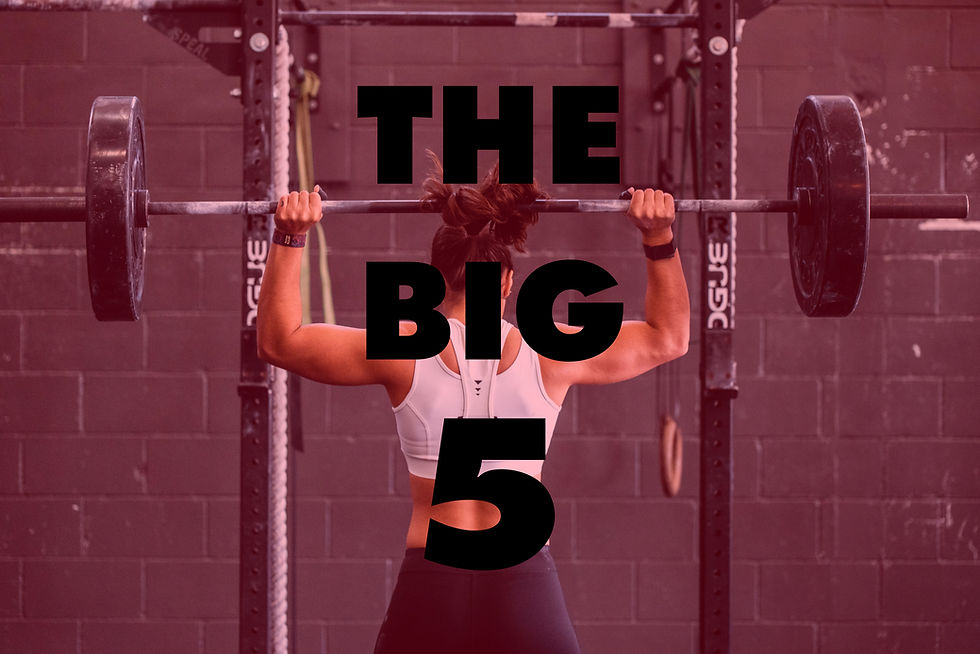Do you want to build a strong, muscular physique? Do you want to improve your athletic performance, have more confidence, and be the first person your friends call when they need help moving?
Except for that last part, there's not much downside to being strong. But it takes hard work and a carefully crafted plan to get you there.
When I create a fitness plan for my clients to build strength and lean muscle mass, I make sure to incorporate five concepts that are time tested and backed by science. The big 5 - as I call them: The Push, The Pull, The Squat, The Hinge, and the Carry.

The Big 5
Five moves is really all it takes to reach new levels of strength. But not just any five moves. These are specific, functional moves that involve multiple joints and muscle simultaneously working together to create an end result - moving heavy weight. This synchrony of events ensures that the body learns how to work optimally - meaning you get stronger, faster, and more athletic.
In addition, more joints working together means more weight being moved, meaning more stress on the muscles themselves. For people wanting to get stronger - this is how it's done. For people wanting to build more muscle, this is also how it's done.
But keep in mind strength and muscle size are different things. They can be trained separately. Regardless of if you want to be big or strong, both strategies involve using the Big 5 as a foundation.
All of these moves can be done with body weight, or with equipment like barbells, dumbbells, and machines.
The Push

The push is probably the first thing people imagine when they think "strength training". This move involves using your shoulders, triceps, chest, shoulder blades, upper back, core, and even legs to push an object away from you.
Examples of the push involve pushups, bench press, dumbbell presses, overhead presses, push presses, and so on. Any move where the weight starts close to you and ends at a distance is a push.
Pushing is important, but like any exercise, proper form should be observed. Also keep in mind that not all shoulders are created equal. Some people are not designed to push overhead - it may cause pain and damage the shoulders.
The Pull

The pull is the opposite of the push. Any move where a weight or object starts away from you and ends closer - that's a pull. Pulling targets the upper back, biceps, rear shoulders, ab and core muscles, and sometimes even hamstrings and glutes.
Examples of the pull include pullups, inverted rows, barbell or dumbbell rows, lat pulldowns, bent over rows, and pretty much anything with "row" in the name.
For most people, I recommend pulling at least 2x as much as pushing. I program a minimum of a 2:1 [pull:push] ratio for my clients. This means that pulling should be included two times for every pushing exercise. Most people have bad posture from sitting all day, office work, or specific sport requirements. This 2:1 pulling ratio is to ensure proper posture, shoulder health, and overall upper body health.
The Squat

The squat is the quintessential lower body exercise. It hits all the major leg muscles and builds strength and stability around the hips, knees, and ankles. If you want to get strong, the squat is our go-to exercise. If you want to build muscle, the squat is our go-to exercise. If you want to run faster or jump higher, the squat is our go-to exercise. You get the idea.
Contrary to popular mis-information, squats don't hurt your knees - bad squats hurt your knees. Squatting is actually GREAT for reducing pain in the knees, hips, and back. Not all squats are created equal, though, as there are a ton of variations depending on your needs and what equipment you have available.
The Hinge

The hinge is a move that utilizes the hips, glutes, hamstrings, low back, upper back, and a ton of other muscles. The hinge is visually similar to a squat - but upon further inspection is quite different.
The hinge is caused when most of the movement comes from the hips instead of the knees. A proper hinge requires very little knee bend. A hinge move targets mostly the posterior chain (glutes, hamstrings, low back).
Common examples of a hinge are deadlifts, kettlebell swings, and good mornings.
Proper hinge technique is essential to help manage and treat low back pain. It's especially useful if you SIT all day.
The Carry

While most coaches all agree on the top four, the fifth "essential" exercise is usually open to interpretation. Some suggest core work as the fifth move, some say lunges, but I'm going to suggest an alternative: The Carry.
The carry is exactly what it sounds like - carrying heavy things. Usually while walking. Sometimes holding a heavy thing overhead. It's something you likely do everyday.
A good carry targets the whole body - including the core muscles. It creates strength and stability in all of your muscles from the shoulders, to the abs, to the hips, to the calves.
The carry is dynamic, meaning your muscles must adapt to the stress while in motion. This translates well to sports, rehab, posture, and overall "real life".
Do These Things
If you want to get strong, build muscle, increase your metabolism, and be overall tough - these are the five things you need to incorporate into your fitness plan. Just don't forget to help out your friends when they need a hand moving furniture. Being strong is both a blessing and a curse.
MORE Information
.png)
Comments